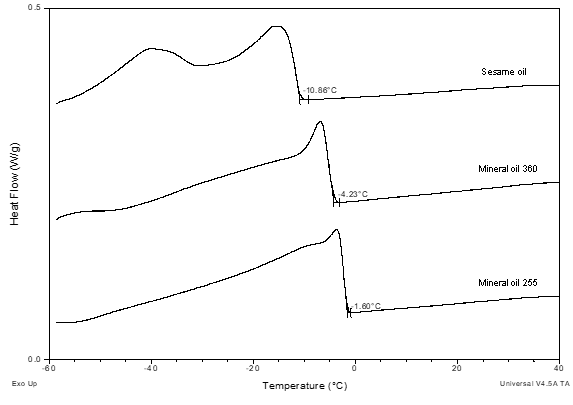Estudio comparativo de las propiedades térmicas del aceite de ajonjolí y dos aceites minerales de diferente viscosidad
DOI:
https://doi.org/10.17981/ingecuc.15.2.2019.10Palabras clave:
aceite mineral, punto de fluidez, temperatura de fusión, estabilidad térmica, estabilidad oxidativa, ECD, aceite de sésamoResumen
Introducción: En los últimos años, la investigación y el desarrollo de biolubricantes a partir de aceites vegetales ha aumentado para minimizar el impacto en el medio ambiente de los derivados del petróleo.
Objetivo: En este trabajo, se realizó un estudio comparativo de las propiedades térmicas del aceite de sésamo con las de dos aceites minerales de viscosidad media y alta (360 y 255) libres de aditivos.
Método: La caracterización de los tres aceites se realizó mediante la técnica de espectroscopia infrarroja (FT-IR) y propiedades físicas como viscosidad cinemática, densidad, propiedades térmicas y oxidativas se determinaron mediante el análisis del escaneo de calorimetría diferencial (ECD).
Resultados: El aceite de sésamo tenía un punto de fluidez de - 14.67 ° C, temperatura más baja que para los aceites minerales 255 y 360, (- 4.29 ° C y - 6.89 ° C, respectivamente). El alto contenido de ácidos grasos insaturados (84.86%) podría ser responsable de este comportamiento. Los aceites fueron estables en temperaturas cercanas a 250 ° C y con atmósfera de nitrógeno. Los aceites minerales son más estables a la oxidación debido a su alto contenido de ácidos grasos con cadenas de hidrocarburos saturadas sin sitios oxidables.
Conclusiones: Sin embargo, la baja estabilidad del aceite de sésamo se debe al alto contenido de ácidos grasos insaturados, el uso de antioxidantes, aditivos o una modificación química de las cadenas insaturadas, esta propiedad podría ser mejorada para usar el aceite como lubricante.
Descargas
Citas
T. M. Panchal, A. Patel, D. T. M. Chauhan and J. V. Patel, “A methodological review on bio-lubricants from vegetable oil based resources,” Renew. Sust. Energ. Rev., vol. 70, no. C, pp. 65–70, Apr. 2017. https://doi.org/10.1016/j.rser.2016.11.105
O. Ocheje, M. Matthew, A. Manase and E. Ifechukwu, “Optimization of the operating parameters for the extractive synthesis of biolubricant from sesame seed oil via response surface methodology,” Egypt. J. Petrol., vol. 27, no. 3, pp. 265–275, Sept. 2018. https://doi.org/10.1016/j.ejpe.2017.04.001
J. McNutt and H. Quan, “Development of biolubricants from vegetable oils via chemical modification,” J. Ind. Eng. Chem., vol. 36, pp. 1–12, Apr. 2016. https://doi.org/10.1016/j.jiec.2016.02.008
S. Gharby, H. Harhar, Z. Bouzoubaa, A. Asdabi, A. El Yadini and Z. Charrouf, “Chemical characterization and oxidative stability of seeds and oil of sesame grown in Morocco,” J. Saudi Soc. Agric. Sci., vol. 16, no. 2, pp. 105–111, Apr. 2017. https://doi.org/10.1016/j.jssas.2015.03.004
S. Long-Kai, Z. Li, L. Rui-Jie, C. Ming, J. Qing-Zhe and W. Xing-Guo, “Chemical Characterization, Oxidative Stability, and In Vitro Antioxidant Capacity of Sesame Oils Extracted by Supercritical and Subcritical Techniques and Conventional Methods: A Comparative Study Using Chemometrics,” Eur. J. Lipid Sci. Technol., vol. 120, no. 2, pp. 1–11, Sept. 2017. https://doi.org/10.1002/ejlt.201700326
S. Sabarinath, P. Kumarapillai and R. Perikinalil, “Evaluation of physicochemical, thermal and tribological properties of sesame oil (Sesamum indicum L.): a potential agricultural crop base stock for eco-friendly industrial lubricants,” IJARGE, vol. 13, no. 1, pp. 77–90, May. 2017. https://doi.org/10.1504/IJARGE.2017.084037
J. P. Ríos L., D. E. Salazar L. and C. Puente, “Diseño y contrucción de un equipo para la extracción de aceite de sésamo (Sesamum indicum) y nuez (Juglans regia),” Trabajo Titulación, Fac. Cienc., Esc. Sup. Politécnica de Chimborazo, Riobamba, Ecuador, 2018. Available: http://dspace.espoch.edu.ec/bitstream/123456789/10505/1/96T00503.pdf
Y. Junpeng, Z. Qi, L. Xin, W. Xinsheng, L. Bing and Z. Wenxue, “Steam explosion technology based for oil extraction from sesame (Sesamum indicum L.) seed,” J. Saudi Soc. Agric. Sci., vol. 18, no. 1, pp. 1–6, Jan. 2019. https://doi.org/10.1016/j.jssas.2016.10.003
C. J. Reeves, P. L. Menezes, J. T.-C. Jen and M. L. Lovell, “The influence of fatty acids on tribological and thermal properties of natural oils as sustainable biolubricants,” Tribol. Inter., vol. 90, pp. 123–134, Oct. 2015. https://doi.org/10.1016/j.triboint.2015.04.021
M. Azhari, M. F. Tamar, N. R. Mat Nuri and M. R. Yusoff, “Physical property modification of vegetable oil as bio-lubricant using ZDDP,” ARPN JEAS, vol. 10, no. 15, pp. 6525–6528, Aug. 2015.
W. M. Guezmil, S. M. Bensalah and S. Mezlini, “Effect of bio-lubrication on the tribological behavior of UHMWPE against M30NW stainless steel,” Tribol. Inter., vol. 94, pp. 550–559, Feb. 2016. https://doi.org/10.1016/j.triboint.2015.10.022
Q. Baokun, Z. Qiaozhi, S. Xiaonan, W. Zhongjiang, L. Yang and J. Lianzhou, “Differential scanning calorimetry study—Assessing the influence of composition of vegetable oils on oxidation,” Food Chem., vol. 194, pp. 601–607, Mar. 2016. https://doi.org/10.1016/j.foodchem.2015.07.148
L. Honary and E. Richter, “Biobased Lubricants Technology,” in Biobased Lubricants and Greases: Technology and Products, Hoboken, Nueva Jersey, USA: John Wiley & Sons, 2011. https://doi.org/10.1002/9780470971956.ch7
W.-H. Wu, “The contents of lignans in commercial sesame oils of Taiwan and their changes during heating,” Food Chem., vol. 104, no. 1, pp. 341–344, Dec. 2007. https://doi.org/10.1016/j.foodchem.2006.11.055
M. T. Siniawski, N. Saniei, B. Adhikari and L. Doezema, “Influence of fatty acid composition on the tribological performance of two vegetable-based lubricants,” J. Synth. Lubr., vol. 24, no. 2, pp. 101–110, Mar. 2007. https://doi.org/10.1002/jsl.32
M. R. Tiwari, K. K. Tiwari and S. D. Toliwal, “Studies on Thermal Stability of Palm -Sesame oil blends during Deep Fat Frying,” J. Sci. Ind. Res., vol. 73, pp. 153–156, Mar. 2015.
A. E. Delgado, R. G. García and W. A. Aperador, “Estudio del Poder Lubricante del Aceite de Ajonjolí con Adición de Nanopartículas de Cobre,” Inf. Tecn., vol. 27, no. 6, pp. 175–184, Dec. 2016. https://doi.org/10.4067/S0718-07642016000600018
P. Ghosh, M. Hoque and G. Karmakar, “Castor oil as potential multifunctional additive in the formulation of eco-friendly lubricant,” Polym. Bull., vol. 75, no. 2, pp. 501–514, May. 2017. https://doi.org/10.1007/s00289-017-2047-6
T. Yakubu, S. Albert, A. Salawu, M. Olutoye and M. Ojapah, “Vegetable oil based lubricants: Challenges and prospects,” Tribol. Online, vol. 14, no. 2, pp. 60–70, Jun. 2019. https://doi.org/10.2474/trol.14.60
M. Menkiti, O. Ocholi, K. Oyoh and O. Onukwuli, “Synthesis and Tribological Evaluation of Sesame OilBased Trimethylolpropane Ester,” J. Chinese Advanced Materials Society, vol. 3, no. 2, pp. 71–88, Mar. 2015. https://doi.org/10.1080/22243682.2015.1013154
O. Gorkem, Y. Rusen M., T. Omer S., K. Salih and D. M. Zeki, “Rapid detection of adulteration of cold pressed sesame oil adultered with hazelnut, canola, and sunflower oils using ATR-FTIR spectroscopy combined with chemometric,” Food Control, vol. 82, pp. 212–216, Dec. 2017. https://doi.org/10.1016/j.foodcont.2017.06.034
G. Karmakar, P. Ghosh and B. K. Sharma, “Chemically Modifying Vegetable Oils to Prepare Green Lubricants,” Lubricants, vol. 5, no. 4, pp. 1–17, Nov. 2017. https://doi.org/10.3390/lubricants5040044
G. Karmakar and P. Ghosh, “Soybean Oil as a Biocompatible Multifunctional Additive for Lubricating Oil,” ACS Sustainable Chem. Eng., vol. 3, no. 1, pp. 19–25, Nov. 2014. https://doi.org/10.1021/sc500685r
J. N. Salih, B. M. A. Salimon and E. Yousif, “Thermo-oxidation, friction-reducing and physicochemical properties of ricinoleic acid based-diester biolubricants,” Arab. J. Chem., vol. 10, Supp. 2, pp. S2273–S2280, May. 2017. https://doi.org/10.1016/j.arabjc.2013.08.002

Descargas
Publicado
Cómo citar
Número
Sección
Licencia
Derechos de autor 2019 INGE CUC

Esta obra está bajo una licencia internacional Creative Commons Atribución-NoComercial-SinDerivadas 4.0.
Los artículos publicados son de exclusiva responsabilidad de sus autores y no reflejan necesariamente las opiniones del comité editorial.
La Revista INGE CUC respeta los derechos morales de sus autores, los cuales ceden al comité editorial los derechos patrimoniales del material publicado. A su vez, los autores informan que el presente trabajo es inédito y no ha sido publicado anteriormente.
Todos los artículos están bajo una Licencia Creative Commons Atribución-NoComercial-SinDerivadas 4.0 Internacional.


 English
English
 Español (España)
Español (España)























